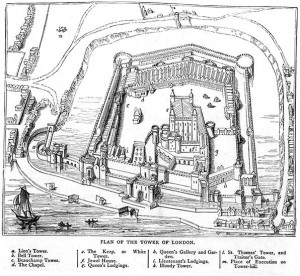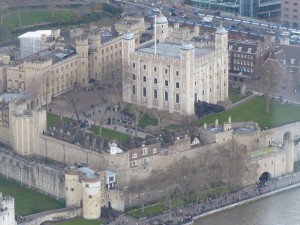Queen Jane’s reign ends
‘The fortress would become in rapid succession her palace, her prison, her scaffold – and her tomb.’
(p.229, Jones)
Queen Jane’s reign ended on 19th July 1553 when the Privy Council declared for Mary. Julius Terentianus wrote to John Ab Ulmis on November 20th 1553 that, ‘Thus Jane was queen for only nine days, and those most turbulent ones.’ (p. 365-274, Robinson)
De Lisle describes how the Duke of Suffolk told his daughter that her reign was at an end. ‘Suffolk found Jane with her mother and her ladies-in-waiting. According to the papal envoy Commendone, Jane did not lose her composure as her father delivered the grim news. Instead, when he had finished, she reminded him that he had helped persuade her to accept the crown.’ (p.123 de Lisle)
Professor Eric Ives writes that ‘Jane, was left to fend for herself, abandoned in the Tower with her husband Guildford Dudley and her mother-in-law, the duchess of Northumberland.’ (p.241, Ives)
At some point the former queen was moved from the Royal apartments in the Tower to the ‘house of Nathaniel Partridge, the gentlemen – gaoler’ (p.249, Ives), which according to the Tower of London website was at ‘No 5 Tower Green, next to the Queen’s House.’ (HRP website)
See Location
Henry Machyn (a citizen and Merchant Taylor of London) reported Mary’s proclamation in his diary.
‘The xix day of July was qwene Mare proclamyd qwene of England, France, and Yrland, and alle domy(ni)ons, [as the] syster of the late kyng Edward the vj. and doythur unto the nobull kyng Henry the viij. be-twyn v and vj of the cloke at nyght, and ther wher at proclamasyon iiij trumpeters and ij harold(s) of armes, and the erle of Arundell, the erle of Shrossbery, th’erle Penbroke, my lord Tressorer, my lord of Preveselle, my lord Cobham, my lord Warden, master Masun, and my lord Mare, and dyvers odur nobull men; and thys was done at the crosse in Chepe, and from that plasse thay whent unto Powlls and ther was Te Deum Laudamus, with song, and the organes playhyng, and all the belles ryngyng thrugh London, and bone-fyres, and tabuls in evere strett, and wyne and bere and alle, and evere strett full of bonfyres, and ther was money cast a-way. ‘ (Machyn – British History Online)
The author of the Chronicle of the Grey Friars wrote:
‘Item the xix. day of the same monyth, [which] was sent Margarettes evyne, at iiij. of clocke at after-none was proclamyd lady Ma[ry to] be qwene of Ynglond at the crose in Cheppe with the erle of Shrewsbery, the earle [of Arundel], the erle of Pembroke, with the mayer of London, and dyvers other lordes, and many of the ald[dermen] and the kynges schrffe master Garrand, with dyvers haroldes and trompettes. And from thens cam to Powlles alle, and there the qwere sange Te Deum with the organs goynge, with the belles ryngynge, the most parte alle [London], and that same nyght had the [most] parte of London Te Deum, with bone-fyers in every strete in London, with good chere at every bone [fyer], the belles ryngynge in every parych cherch, and for the most parte alle nyght tyll the nexte daye to none. ‘
From: ‘The Chronicle of the Grey Friars: Mary’, Chronicle of the Grey Friars of London: Camden Society old series, volume 53 (1852), pp. 80-98. URL: http://www.british-history.ac.uk/report.aspx?compid=51590 Date accessed: 15 July 2013.
The author of ‘A London Chronicle’ wrote:
‘Neuerthelesse, thankes be to God, the Wednysday, beynge ye xix.th of Jully, at v. of ye clocke in ye afternone ye hole body of ye counsel, wh. were lefte behynd in ye Tower, assembled at Baynardes castell, & ther communed wt ye erle of Penbroke, & ymedyatly came into Chepesyde wt ye kynge of heraudes, wher they proclaymed ye vertuous lady Mary, doughter of quene Kateryn, quene of England, ffraunce &c., (fn. 1) in earth ye supreme heade: ye Joye wherof wonderfull, for some caste money abrod, & some made bonfyars thorowe ye whole cyte: ye prayses were geuen to God in ye churches wt te deum & orgaynes, belles ryngynge & euery wher ye tables spredd in ye stretes, meate & drynke plentye, wyne geuen ffrely of many men, and a greate peale of ordynaunce was shote of at ye Tower.’
From: ‘A London Chronicle: Mary’, Two London Chronicles from the Collections of John Stow (1910), pp. 27-43. URL: http://www.british-history.ac.uk/report.aspx?compid=81145 Date accessed: 15 July 2013.
The Ambassadors in England reported the following to Prince Philip on July 20th:
‘Whether the Council were afraid, or for some other reason, they caused the Lady Mary to be proclaimed Queen on the 19th of this month, after having called back to his former seat Paget, who had been expelled by the Duke. On that occasion the people showed unspeakable joy, both in public, in private and in the streets, shooting off salvoes of artillery and indulging in the accustomed sports and games. On the other hand, when the Duke of Suffolk’s daughter was proclaimed, there was no pretence of rejoicing.’
From: ‘Spain: July 1553, 16-20’, Calendar of State Papers, Spain, Volume 11: 1553 (1916), pp. 90-109. URL: http://www.british-history.ac.uk/report.aspx?compid=88485 Date accessed: 15 July 2013.
Also dated 20th July, ‘ Advices from England’ (written by an Italian resident in London) reported:
‘The other Queen has renounced all her honours, and has been shut up in the Tower with her husband and the Duke’s wife, though all the rest are outside. I know nothing more of the Duke’s movements for the moment: but he must have heard of what has happened here. He will hardly escape. I will send you more news in another letter.’
From: ‘Spain: July 1553, 16-20’, Calendar of State Papers, Spain, Volume 11: 1553 (1916), pp. 90-109. URL: http://www.british-history.ac.uk/report.aspx?compid=88485 Date accessed: 15 July 2013.
On the 22nd July, the Ambassadors in England wrote the following to the Emperor, Charles V:
‘The Duchess of Northumberland, Guilford, her son, and the Lady Jane of Suffolk are detained in the Tower as prisoners, and receive sour treatment, somewhat different from that meted out to them during their eight days’ reign. Guilford tried to induce his wife to cede her right to the Crown to him, so that he might not only be consort and administrator (administrateur), but king in person, intending to have himself confirmed as such by Parliament. But she refused to do so, and gave him the title of Duke of Clarence, which is reserved for the younger son of the king. He already had himself addressed as “Your Grace” and “Your Excellency,” sat at the head of the Council board, and was served alone. At present the Tower jailor serves him at table, and stands in the stead of his captain of the guard.
We have been assured that when the Duke of Suffolk heard that the Council had decided to confirm Queen Mary in her right, he went to the Lady Jane, who was at supper, and tore down the canopy, saying no more than that it was not for her to use it, for her position permitted her not to do so. When the Lady Jane heard of the Council’s determination, she replied that she would give it (i.e. the royal dignity) up as gladly as she had accepted it; she knew that the right belonged to Queen Mary, and the part she had played had been prepared for her without her knowledge. Her father, the Duke, went to the Lord High Treasurer and said to him that as they had been friends in the past, they must remain so in the future, and he hoped the Treasurer would play the part of a friend and obtain the Queen’s pardon to save him and his family. The Treasurer answered that he was in the same position as the other, and no surer of his safety; though if he could he would certainly help him.’
From: ‘Spain: July 1553, 21-31’, Calendar of State Papers, Spain, Volume 11: 1553 (1916), pp. 109-127. URL: http://www.british-history.ac.uk/report.aspx?compid=88486 Date accessed: 15 July 2013.
Location
The Tower of London is in central London on the north bank of the Thames.
The Queen’s House was formerly the Lieutenant’s Lodgings and Nathaniel Partridge’s house is between c – the Beauchamp Tower (where Guildford Dudley was held) and i – the Lieutenant’s Lodging
Some Key Dates in the Tudor History of the Tower of London
‘1503 – 11 February – Queen Elizabeth of York dies just over a week after giving birth.
1509 – 21 June – King Henry VIII arrives at the Tower to prepare for his coronation.
1536 – 19 May – Anne Boleyn is executed.
1542 – 13 February – Katherine Howard and Lady Jane Rochford are executed.
1547 – 19 February – King Edward VI leaves for his coronation procession.
1553 – 10 July – Queen Jane takes possession of the Tower.
1553 – 19 July – Queen Jane’s reign ends at the Tower.
1553 – 3 August – Queen Mary I takes possession of the Tower.
1553 – 22 August – John Dudley, Duke of Northumberland is executed.
1553 – 29 August – The author of the ‘Chronicle of Queen Jane etc’ dines with Lady Jane at Nathaniel Partridge’s house.
1554 – 12 February – Lady Jane and Lord Guildford Dudley are executed.
1554 – 23 February – Henry Grey, Duke of Suffolk is executed.
1558 – 12 January – Elizabeth I arrives to prepare for her coronation.’
From ‘On This Day in Tudor History by Claire Ridgway.’
The Tower of London Today
Sources
De Lisle, L. (2010) The Sisters Who Would Be Queen: The Tragedy of Mary, Katherine and Lady Jane Grey, HarperPress.
Ives, E. (2009) Lady Jane Grey: A Tudor Mystery, Wiley-Blackwell.
Jones, N. (2011) Tower: An Epic History of the Tower of London, Windmill Books
Nichols, J. G (ed) (1850) The Chronicle of Queen Jane and of Two Years of Queen Mary and Especially of the Rebellion of Sir Thomas Wyatt, Written by a Resident in the Tower of London, Llanerch Publishers
Ridgway, C. (2012) On This Day in Tudor History, Made Global Publishing.
Robinson, H (ed), (1846) Original Letters Relative to the English Reformation, Written during the Reigns of King Henry VIII, King Edward VI and Queen Mary (Volume One), University Press
‘Diary: 1553 (Jul – Dec)’, The Diary of Henry Machyn: Citizen and Merchant-Taylor of London (1550-1563) (1848), pp. 34-50. URL: http://www.british-history.ac.uk/report.aspx?compid=45512 Date accessed: 15 July 2013.
‘The Chronicle of the Grey Friars: Mary’, Chronicle of the Grey Friars of London: Camden Society old series, volume 53 (1852), pp. 80-98. URL: http://www.british-history.ac.uk/report.aspx?compid=51590 Date accessed: 15 July 2013.
‘A London Chronicle: Mary’, Two London Chronicles from the Collections of John Stow (1910), pp. 27-43. URL: http://www.british-history.ac.uk/report.aspx?compid=81145 Date accessed: 15 July 2013.
‘Spain: July 1553, 16-20’, Calendar of State Papers, Spain, Volume 11: 1553 (1916), pp. 90-109. URL: http://www.british-history.ac.uk/report.aspx?compid=88485 Date accessed: 15 July 2013.
‘Spain: July 1553, 21-31’, Calendar of State Papers, Spain, Volume 11: 1553 (1916), pp. 109-127. URL: http://www.british-history.ac.uk/report.aspx?compid=88486 Date accessed: 15 July 2013.






































